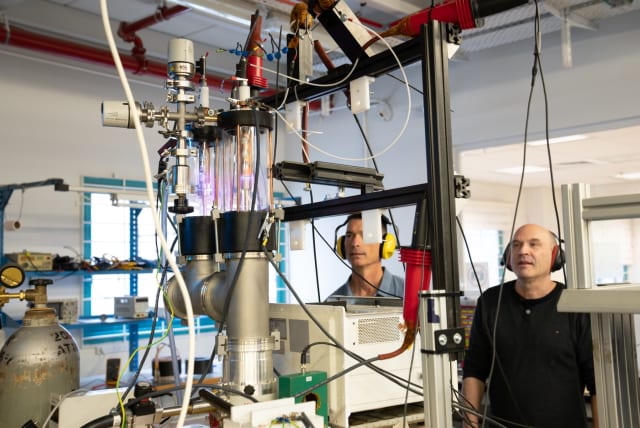Could Israel’s fusion energy co. power our future factories and cities?

While several companies worldwide are working toward nuclear fusion, only one company in Israel has jumped full-throttle into the effort: NT-Tao.
The ability to produce energy via nuclear fusion could significantly impact the environment and geo-strategic and economic development issues.
While several companies worldwide are working toward nuclear fusion, only one company in Israel has jumped full-throttle into the effort: NT-Tao is Israel's first and only start-up in the field of nuclear fusion. The company aims to build a compact fusion device that will be scalable enough to power anything from a factory to an entire city - enabling the world to transition away from oil, natural gas and coal.
What is fusion?
Nuclear fusion generates clean energy by fusing atoms, unlike nuclear fission, which produces energy by splitting atoms. Fission is a primary environmental concern because atomic power produced by fission creates radioactive wastes that can remain dangerous to human health for thousands of years.
In contrast, nuclear energy produced by fusion doesn't generate long-term radioactive nuclear waste.
Specifically, to achieve fusion, two hydrogen atoms need to be melded together to form a helium atom.
NT-Tao was founded in 2016 by Oded Gour-Lavie, Doron Weinfeld and Boaz Weinfeld and incorporated in 2019. In 2021, Gour-Lavie told The Jerusalem Post, the company had a significant breakthrough when it managed to develop a highly efficient heating technology of the hydrogen plasma at high density.
This task, Gour-Lavie said, can be very challenging. Scientists have been working on nuclear fusion for around 80 years. That's because to achieve enough energy, you need more than two hydrogen atoms; you need thousands.
Gour-Lavie said the company's plasma heating method is expected to reach 1,000 times higher density than other fusion reactors, making its fusion reaction 1 million times more effective and resulting in significantly greater energy production than other developing solutions.
Gour-Lavie focused on energy after completing a 30-year career in the Israeli Navy and IDF.
"I was thinking, what is the next thing I am going to do?" he told the Post. "I knew it had to be energy.
"I saw the big problem of energy and climate change and the need to stop global warming, and I realized that no amount of renewable energy will solve these problems," he continued. "Even with renewables and energy storage, it will still be challenging to meet the increasing energy demand."
Israel never got into fusion because "it was not something that can be done on a shoestring budget" and because of the time that could be involved in development. But Gour-Lavie said he could not imagine how Israel could stay outside of the race for fusion "when we have such a strong entrepreneurship ecosystem in Israel and so many smart people with out-of-the-box thinking."
He said the company decided just to get started and figured that if they failed, at least they would benefit humanity. But in the last few years, more private sector members outside of Israel are jumping on board. In addition, the Energy Ministry recently committed $11.5 million to establish a nuclear fusion institute with several universities and NT-Tao.
According to a study published last year, the market for nuclear fusion is expected to be worth $471.99 billion globally in 2030 and $843.46 billion by 2040.
In February, NT-Tao announced it raised $22 million.
"A lot of money is coming from private actors now, which was not the case 10 to 15 years ago," said Terra Venture Partners managing partner and physicist Dr. Astorre Modena. "Companies are raising even billions of dollars to achieve this commercially."
Though Modena cautioned: Fusion energy will likely only be achieved in a long while.
"There are a lot of big steps ahead, and we are still very far from the commercialization of fusion energy," Modena said. "The prototype could be achieved at best in 10 to 15 years."
But Gour-Lavie said NT-Tao is more ambitious. He said he hopes "we will be able to produce a prototype and come to the aid of climate change by the end of this decade" - meaning within the next seven years.
"What we are doing is a super aggressive plan, but I think we can do it," he said. "Our system is smaller, and the advantage of a small system is that it costs less to do many quick experiments."
Nonetheless, he added, “for global warming, we will need a combination of more renewables until fusion does come into full play."
Jerusalem Post Store
`; document.getElementById("linkPremium").innerHTML = cont; var divWithLink = document.getElementById("premium-link"); if (divWithLink !== null && divWithLink !== 'undefined') { divWithLink.style.border = "solid 1px #cb0f3e"; divWithLink.style.textAlign = "center"; divWithLink.style.marginBottom = "15px"; divWithLink.style.marginTop = "15px"; divWithLink.style.width = "100%"; divWithLink.style.backgroundColor = "#122952"; divWithLink.style.color = "#ffffff"; divWithLink.style.lineHeight = "1.5"; } } (function (v, i) { });


